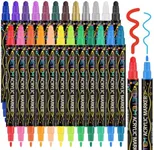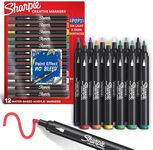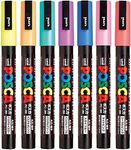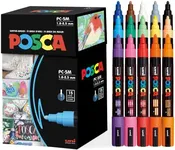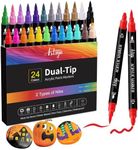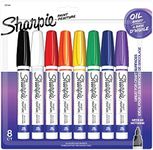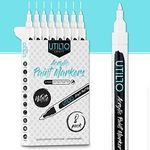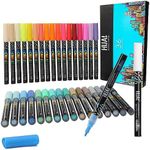Buying Guide for the Best Paint Markers
Choosing the right paint markers can make a big difference in your art, craft, or DIY projects. Paint markers are versatile tools that allow you to add color, detail, and design to a variety of surfaces. To find the best fit for your needs, it's important to understand the key features that set different paint markers apart. By considering these features, you can select markers that will work well for your specific projects and preferences.Ink TypeInk type refers to the kind of paint or pigment inside the marker. The most common types are oil-based, water-based, and acrylic. Oil-based markers are durable and work well on non-porous surfaces like metal, glass, and plastic, but they can have strong odors and take longer to dry. Water-based markers are easier to clean up, have less odor, and are great for paper, cardboard, and some fabrics, but may not be as permanent on slick surfaces. Acrylic markers offer a balance, being suitable for many surfaces and drying quickly. To choose the right ink type, think about the surfaces you plan to use the markers on and whether you need the marks to be permanent or removable.
Tip Size and ShapeTip size and shape determine how thick or thin your lines will be and how much control you have over your artwork. Tips can range from extra fine (for detailed work and writing) to broad or chisel (for filling in large areas or making bold lines). Some markers have bullet tips for general use, while others have brush tips for more expressive strokes. Consider what kind of work you’ll be doing—detailed illustrations, labeling, or covering large areas—and pick a tip size and shape that matches your needs.
Opacity and CoverageOpacity describes how well the paint covers the surface beneath it. Highly opaque markers will cover dark or colored surfaces easily, while less opaque markers may require multiple layers or may not show up well. If you need your colors to stand out on any background, look for markers that are labeled as highly opaque. If you’re working on light surfaces or want a more transparent effect, lower opacity may be fine. Think about the look you want and the surfaces you’ll use to decide how much coverage you need.
Drying TimeDrying time is how long it takes for the paint to set after you apply it. Fast-drying markers are convenient for quick projects and layering colors without smudging, but they may not give you much time to blend. Slower-drying markers can be useful if you want to blend colors or make adjustments, but they can smudge if touched too soon. Consider whether you need speed or flexibility in your work, and choose accordingly.
Lightfastness and DurabilityLightfastness refers to how well the paint resists fading when exposed to light over time. Durability also includes resistance to water, abrasion, and weather. If your work will be displayed outdoors or in bright light, or if it needs to last a long time, look for markers with high lightfastness and durability. For temporary projects or indoor use, this may be less important. Think about how long you want your work to last and where it will be displayed.
Color RangeColor range is the variety of colors available in a marker line. Some brands offer just a few basic colors, while others have dozens of shades. If you need specific colors for your project or want to experiment with blending and shading, a wider color range will be helpful. If you only need basic colors for labeling or simple designs, a smaller set may be enough. Consider your creative needs and how much variety you want in your palette.
